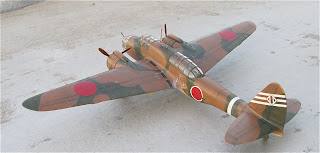It is a delight to be able to continue this brief season of Japanese Army twins with another Kawasaki Ki-48 model built from the Hasegawa (ex-Mania) kit in 1/72 scale, this time by Rob Ronconi. This Lily is all closed up and resplendent in a very effectively realised kumogata scheme to represent an aircraft of Hiko Dai 34 Sentai. The 34th was established in Indo-China in October 1942, serving on the Burma front as part of the 4th Air Brigade from Loilem (near Heho) with 20 aircraft on strength and 15 committed to operations. From February 1944 the unit was deployed to the New Guinea theatre but operated there at very low strength with an average of only 12-13 aircraft and at one point was described as a training unit. Withdrawn twice to the Philippines for refitting it was disbanded in August 1944.
Image credit: All photos © 2020 Rob Ronconi




















































